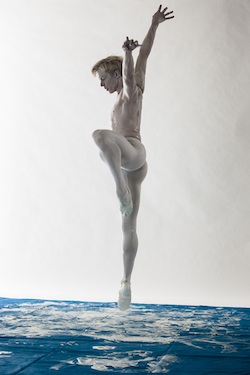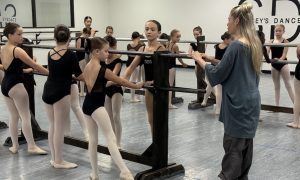By Stephanie Wolf.
Nowadays, there are so many ways to stay connected. Social media is a driving force in this realm of digital correspondence, opening up an array of interesting opportunities to the dance industry. But with so many options orbiting out in cyberspace, how do we decipher the best way to wield this powerful tool so that’s it’s the most beneficial for a dance career?
Why social media?
Social media guru Gabriela Simich remembers the day she opened her first Facebook account while attending the University of Alabama. She was so excited by her new fascination she insisted all her friends jump on the virtual bandwagon. She even intertwined her love affair with online media into her grad school thesis at UC-Irvine.
However, before the cybernetic stars aligned for Simich, she investigated how to bring more awareness to dance. While performing with Nevada Ballet Theatre, Simich had a candid conversation with Artistic Director James Canfield about the business aspects of a regional ballet company. When discussing the infrastructure, Canfield explained that the dancers always ended up at the bottom of the hierarchy.
“If you can figure out how to take the dancers out of the bottom corner and into the front and center of a ballet company, that is the golden ticket,” he explained.
A light bulb went off; people go to a performance mostly because they feel a connection to the work or an individual dancer. The internet could build on this dancer and dance-goer relationship, thus bringing the dancers to the forefront.
“Little did I know that was going to lead to my career,” she says looking back on the conversation. “It just clicked, it just made sense to me.” Now, she manages social media for seven plus different dance organizations.

Gabriela Simich. Photo by Gloria Plascencia.
The perks of being ‘social’
It’s no longer a question of having a digital presence, but what is done with a digital presence.
“It depends on what your goals are as a dancer,” says Simich. Twitter, which she calls the “king of text,” is great for dance writers or scholars; whereas Facebook, Tumblr and YouTube bring a more visual aspect that can be great for choreographers and independent dancers.
Many within the industry are active online. New York City Ballet Principals Ashley Bouder and Sara Mearns tweet frequently. Sidra Bell uses YouTube to promote her choreography. Alvin Ailey American Dance Theater posts on Facebook multiple times a day.
San Francisco Ballet Principal Dancer Tiit Helimets finds social media a useful mechanism for his career. Like Simich, he first got on Facebook to keep in touch with friends. But he learned quickly it was a great way to promote his side projects.
Aiming to post multiple times a day, Helimets shares updates on his company and choreography. He says his content focuses on “cultural exchange and dancing in general,” and he tries to post at times of the day when people are likely to be browsing the web—a trick he picked up by monitoring email blasts of larger organizations. But, most importantly, he tries not to stress out about it. “It has to be fun in the end,” he says.
Simich measures social media success not just by reach, but also by how many people are liking, commenting and sharing content. It’s all about engagement and being a collaborative experience. Ask relevant questions, post riveting content that appeals to the appropriate audience, and follow other dancers, companies and choreographers to create a true online community.
Ultimately, it’s an experiment. “You might have to try different tactics to see what works for you,” says Simich. “Set realistic goals and [use social analytics to] document what is and isn’t working.”
Get a website
Before going crazy on social media, Simich recommends setting up a website. “It’s so important,” she says. “It should come first and be your guideline for what your look is.”
Keep it simple and readable. With sites like WordPress, SquareSpace and Wix, it’s easier than ever to have a DIY approach to creating a website. Individuals can choose from a variety of templates, so it’s not necessary to be tech savvy.
From this main “hub,” as Simich describes it, a dancer can connect all of his or her social media as well as post photo galleries, reels and even create a blog to chronicle career highlights and updates.

Tiit Helimets. Photo by Alexander Reneff-Olson.
Noteworthy platforms
While Twitter, Facebook and Tumblr may be the most recognized, these aren’t the only platforms worth establishing a presence on. New and noteworthy social media pops up every day.
LinkedIn is a surprisingly great networking tool for dancers. Groups connect like-minded dance artists by discipline or interest. The site also suggests jobs based on keywords from an uploaded resume.
Google + is another great place to promote work. “It’s Google. So when you post, it can show up in a Google search,” says Simich about the biggest pro of being active on it.
FourSquare is a fun place for those who travel frequently. GoSeeDo is another interesting site—Simich calls it a “unique way to connect with an audience.” Another place to display work is AirTime, where videos, photography and music can be uploaded—the site features selected work and allows other members to give constructive feedback.
Most importantly, Simich says to “look around and see where people are.”
How does it translate?
Does engaging with people online really translate to filling more seats in the theater?
Unfortunately, the verdict is still out. But many are experiencing a rewarding interaction with their audience, helping to determine their demographic and making dance-lovers feel more connected to the creative process.
Additionally, there are efficient ways to manage social media, making the process less time consuming. To tweet or post on the go, connect to social media on a mobile device. Or to save time, link accounts together. It’s most important that content is consistent, the intentions are genuine and the emphasis is on interaction.
As to where it’s all going; it’s impossible to say. But Simich is hopeful about the future of dance on the web. “We’re still learning how to use social media,” she says. “I’m really excited about [the possibilities]. I believe in this.”
Image (top): © Arrow | Dreamstime.com













